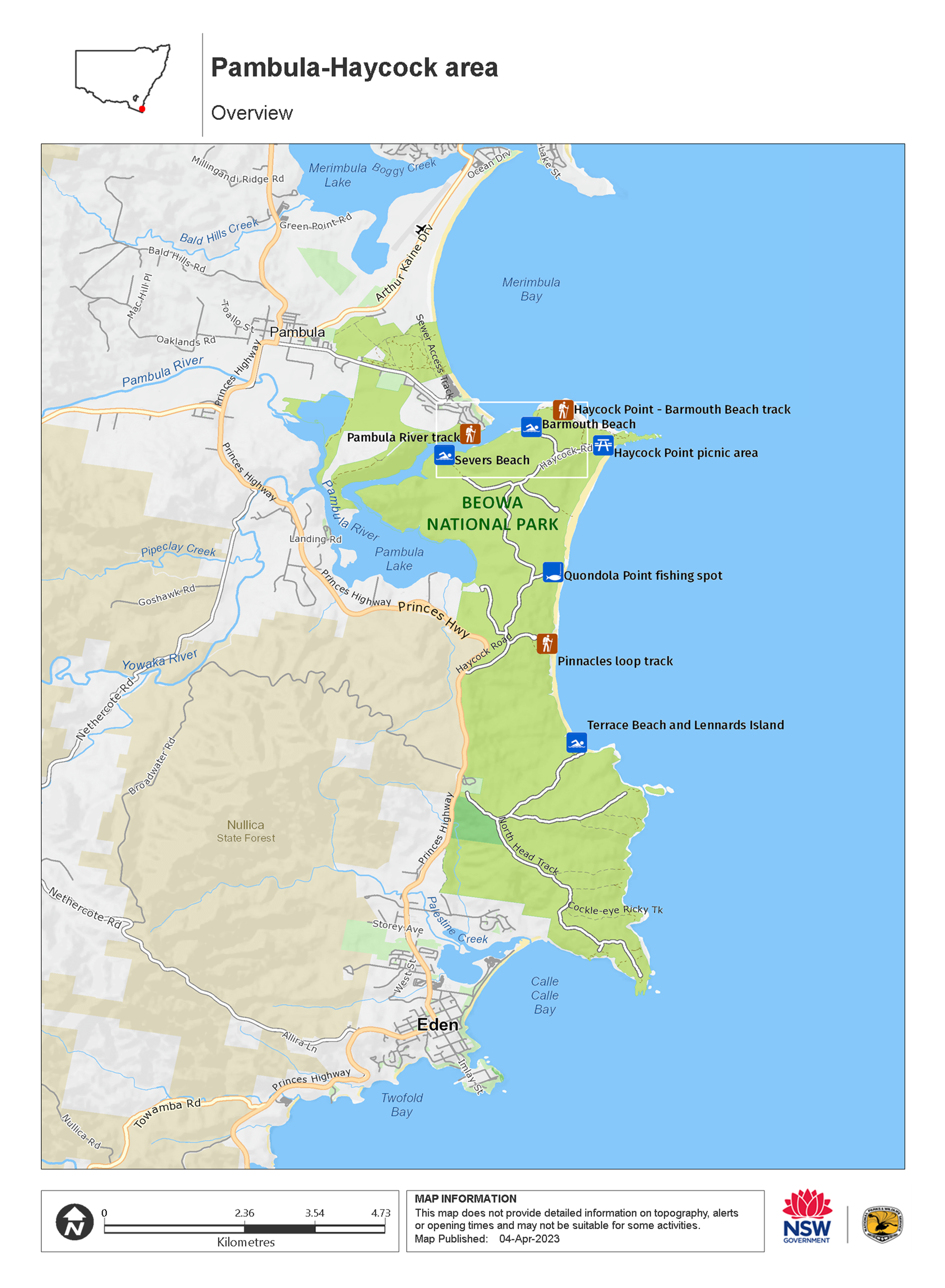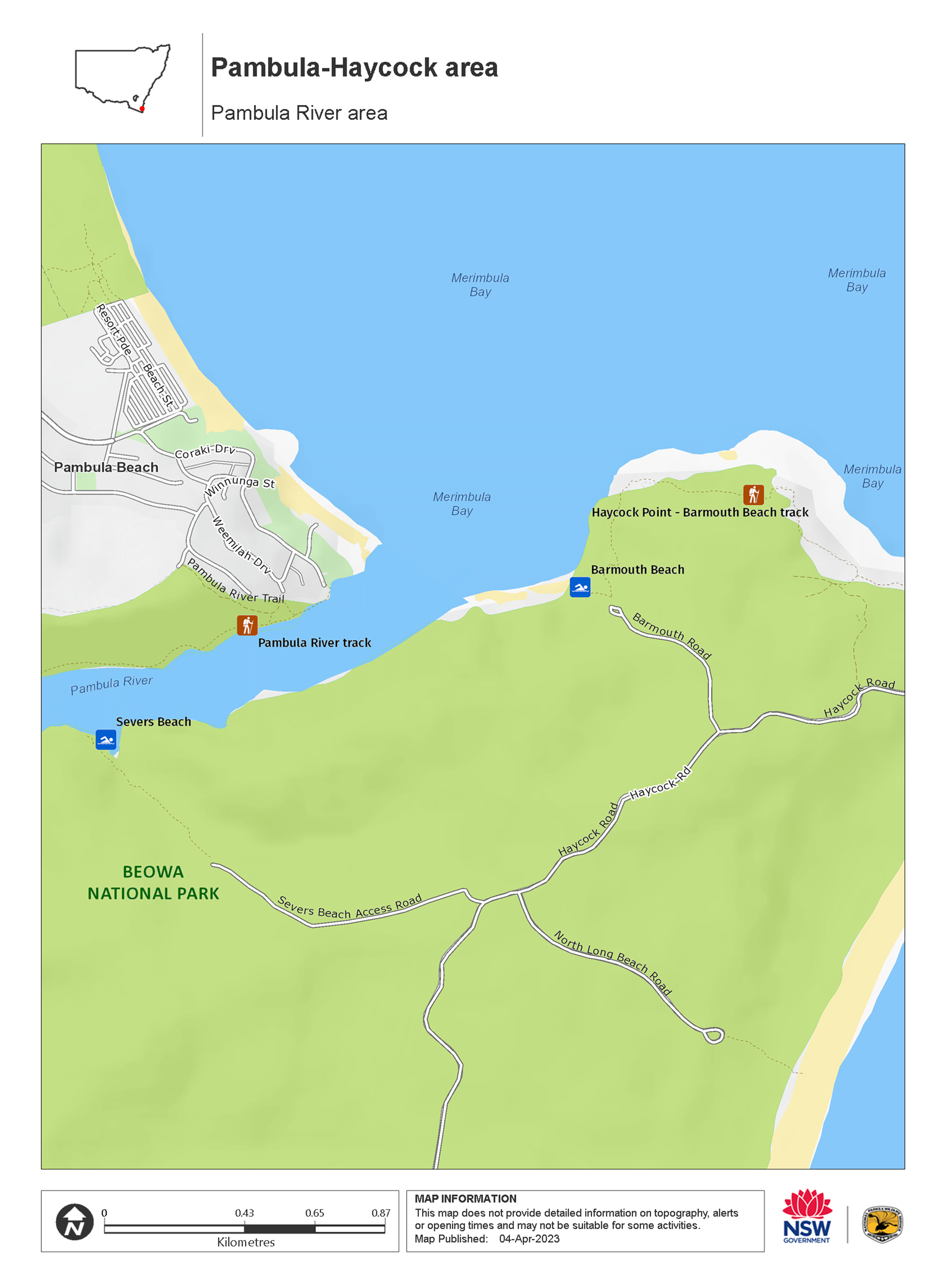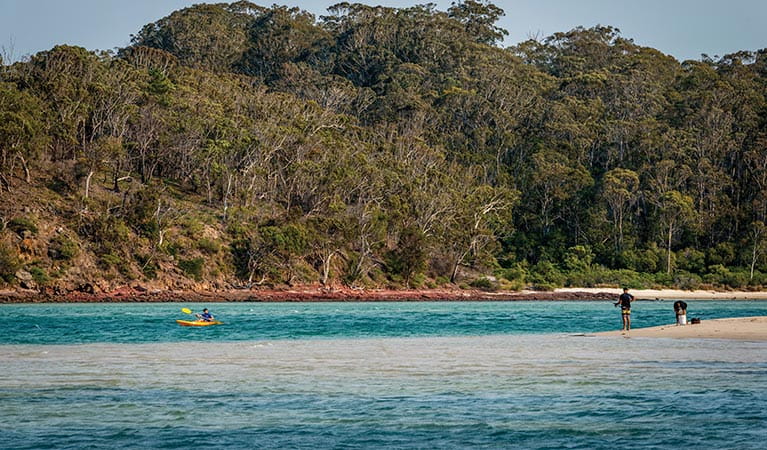Pambula-Haycock area
Beowa National Park
Overview
Pambula-Haycock area is the northern section of Beowa National Park, located between Merimbula and Eden. Explore its sparkling river, fascinating Aboriginal shell middens and secluded beaches.
Read more about Pambula-Haycock area
The park’s Pambula-Haycock area stretches from Pambula Beach to the north head of Twofold Bay. The Pambula river mouth is surrounded on both sides by the national park. Its calm, clear waters make it ideal for kayaking and splashing about with the kids on a hot day.
This area is popular for its pleasant walking tracks that lead you to secluded beaches and headlands. Take a short walk from the carpark to the grassy Severs Beach to see an Aboriginal shell midden carbon dated to 3,500 years old. As you reach the shore, the glistening views of Pambula River will invite you for a swim.
If rocks are your thing, don’t miss The Pinnacles formation—a deep eroded gully of vivid red and white sands. The short loop walk from the carpark will get you there. Walk out to Haycock Point and visit Haystack Rock, an interesting rock formation at the north end of Long Beach.
Haycock Point has some spectacular spots to go whale watching in winter and spring. You’ll see keen fishers casting a line for salmon off Long Beach or Terrace Beach and there’s plenty of bird watching opportunities—look out for the park’s many waterbrids like the hooded plover or the endangered pied oystercatcher.
Pambula’s estuaries are famous for producing oysters. Live like a local and settle in for a picnic on the shores of Haycock Point picnic area with some freshly shucked oysters as you watch the sun set over the Pacific Ocean.
Local alerts
For the latest updates on fires, closures and other alerts in this area, see https://www.nationalparks.nsw.gov.au/visit-a-park/parks/pambula-haycock-area/local-alerts
Map

Map

Map legend

Contact
- in Beowa National Park in the South Coast region
The Pambula-Haycock area of Beowa National Park is always open but may have to close at times due to poor weather or fire danger.
-
-
Merimbula office
02 6495 5000
Contact hours: Monday to Friday and some weekends during peak holiday periods, 10am to 3pm. - 47 Merimbula Drive, cnr Sapphire Coast Drive, Merimbula NSW 2548
-
Email: npws.sapphirecoast@environment.nsw.gov.au
-
Merimbula office
Visitor info
All the practical information you need to know about the Pambula-Haycock area.
Maps and downloads
Nearby towns
Pambula (6 km)
Pambula is a historic river village in majestic rural surroundings. The town is at the mouth of the Pambula River among forests and lakes.
Merimbula (10 km)
The main coastal towns of the Sapphire Coast include Bermagui, Tathra, Merimbula and Eden. This stunning coastline has sparkling beaches and bays, lakes and national parks, all accessible via excellent walking tracks and coastal drives. You'll find beaches just perfect for surfing, swimming and walks.
Eden (15 km)
Eden is a historic whaling town, ideal for a whale-watch tour. It's built around a promontory that juts into Twofold Bay.
Learn more
Pambula-Haycock area is a special place. Here are just some of the reasons why:
Plants and animals protected in this park
Animals
-

Australian pelican (Pelecanus conspicillatus)
The curious pelican is Australia’s largest flying bird and has the longest bill of any bird in the world. These Australian birds are found throughout Australian waterways and the pelican uses its throat pouch to trawl for fish. Pelicans breed all year round, congregating in large colonies on secluded beaches and islands.
-

Australian fur seal (Arctocephalus pusillus doriferus)
The largest fur seal, Australian fur seals are found in isolated rocky outcrops and islands along the NSW coast. They come ashore to form breeding colonies and can often be seen at Barunguba Montague Island Nature Reserve.
Environments in this area
What we're doing
Pambula-Haycock area has management strategies in place to protect and conserve the values of this park. View the detailed park and fire management documents. Here is just some of the work we’re doing to conserve these values:

